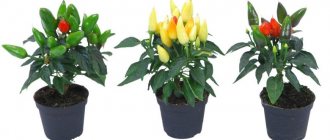I wonder what flower, from a botanical point of view, was discussed in the fairy tale “The Scarlet Flower”? Surely there are different versions, but connoisseurs of beauty will say: “Of course, the fairy tale was about a rose!” One of the most beautiful flowers, combining an attractive aroma, tenderness, chic and regal appearance. Every lover of floriculture sooner or later faces the question of how to grow a rose so that it pleases the eye with both numerous flowers and glossy elastic foliage. So that you can successfully create a pink paradise at home or on your property, we offer a number of useful information about roses and tips for growing them.
To grow a rose, you need to spend time and effort.
Is it possible to grow roses at home?
Not everyone has a plot of land at their disposal, but every apartment has a window sill. It is this that can be turned into a blooming rose garden. For this there are several varieties of roses, which include a wide variety of varieties:
- Miniature : 10 to 30 cm high with dark green leaves. This beauty will bloom almost all year round, except for the winter months. The flowers are double and small.
- Tea : 40−50 cm, distinguished by a variety of shades and long-term flowering.
- Bengal : the most suitable roses for living in an apartment. The height does not exceed 50 cm. The flowers are very fragrant. The lush bush bears white, red or pink flowers.
- Polyanthus : 40−50 cm. Flower colors are mainly cream or pink. Abundant flowering over a long period.
It’s easy to choose a variety of roses, but only an attentive person who loves his mini-rose garden can take proper care of it.
Yellow home rose in a pot
How did the first domestic varieties appear?
Rose bushes began to be grown in China even when civilization was just emerging in Western countries. Rose petals and rose oil were used in perfumery and were used to protect homes from evil spirits.
By the way, we have a whole article with myths and legends about the appearance of roses, as well as their use in the ancient world. You can view it using the link .
Roses have also been grown in Japan for a long time. However, neither in China nor in Japan it took first place among flowers. Chrysanthemums, Lotuses and decorative cherry flowers were revered there at that time.
When traders from the East India Company visited China (early 18th century), they discovered varieties of cultivated roses with small flowers of an unusual crimson color that were completely unknown to Europeans. These were Chinese roses. The first variety to be brought to Europe was "Old Blush" in 1752, followed shortly thereafter by "Slater's Crimson China."
Old Blush
Other Chinese roses appeared in Europe much later. These were tea roses. They had beautifully shaped buds, elegant flowers, a pleasant aroma and long flowering. But these flowers did not tolerate cold weather, so they were often grown indoors. Tea roses can be considered the ancestors of what we understand by the word “indoor rose”.
There are several versions of why this rose was called a tea rose. Some suggest that this is due to the fact that its flowers look like small cups. Others believe that its aroma is similar to the smell of freshly brewed black tea. But it is most likely that the name of this rose is due to the fact that its petals can be brewed and consumed as a drink.
Chinese roses came to England much later. The first rose to be brought there was in 1810 the variety “Hume's Blush Tea-Scented China” (pictured), and in 1844. The variety "Park's Yellow Tea-Scnted China" came to Britain.
Through the efforts of breeders at the end of the 18th - beginning of the 19th centuries, groups of new varieties of roses with repeated flowering - the so-called remontant roses - were obtained. And from crossing remontant roses with tea roses, hybrid tea roses were obtained.
The first variety in the group of hybrid tea roses is considered to be the “La France” variety, which was obtained in 1867. This significant date is considered to be the date of birth of the modern rose.
At first, the new roses were not so popular. Their spread began with the appearance of such magnificent varieties as “Madame Caroline Testout” and “Lady Mary Fitzwilliam” (pictured).
At the beginning of the 20th century in the city of Lyon, the French rose breeder Joseph Pernet-Duchet (1851-1928) crossed a remontant park red rose with a yellow-flowering rose variety “Persian Yellow”. The result was a wonderful new variety with almost yellow flowers and shiny leaves, which was named “Soleil d'Or”. Since that time, the hybrid tea Rose has won the crown of the Queen of Roses and holds it to this day.
Soleil d'Or
Already in 1910, a variety with pure yellow flowers “Rayon d'Or” appeared. At that time, flowers had a cone-shaped center. In 1912, a rose of an even more elegant shape was obtained. The variety was named "Ophelia".
Ophelia
During the period between the two world wars, many magnificent varieties were developed, such as “Etoile Hollande”, “Betty Uprichard”, “Shot Silk”, “Mrs Sam McGredy”, “Crimson Glory”, “Peace” and others.
Superstar
After the end of the Second World War, new varieties began to appear continuously. In 1960, the German variety “Super Star” appeared in Britain - the first coral-orange rose. Then the varieties “Fragrant Cloud”, “Alec's Red”, “Alexander”, “Silver Jubilee” and others were bred. The work of breeders on developing new varieties of hybrid tea roses continues.
Note that breeding one new rose variety requires about two thousand seedlings and several years of crossbreeding work by the breeder. There is an opinion that there will never be a perfect rose. Indeed, in addition to its excellent appearance (color, shape of buds and petals) and aroma, other qualities of a flower are also important - the duration of flowering, resistance to infections, resistance to unfavorable living conditions, etc.
Ways to grow roses
The rose you admired in someone else’s garden is not always purchased from a nursery. After all, most varieties of these wonderful flowers can be grown independently, albeit with some effort. This is how you can quite easily replenish your collection of the queen of flowers.
Roses are usually grown in the following ways:
- using seeds;
- using cuttings.
There are others, but they are less successful, so we won’t waste your time and focus on already proven methods.
How to grow a rose from seeds
Step-by-step instructions for growing roses from seeds:
- We disinfect the seeds: put the planting material in a container and pour 3% hydrogen peroxide into it for 20 minutes. This action is necessary to prevent the formation of mold. Those seeds that float to the surface are immediately removed. At the end of soaking, the peroxide is drained.
- After this, a long period of stratification is carried out - by recreating the natural wintering conditions of the seeds, we accelerate their germination. To do this, take a shallow container and line its bottom with a cloth well moistened with hydrogen peroxide. Seed material is laid out on it. The same damp cloth is placed on top. The so-called substrate is wrapped in polyethylene and placed in the lower vegetable compartment of the refrigerator for 1.5-2 months. Storage temperature - from +5 to +8 degrees.
- If you purchased several varieties of a flower, then the seeds are laid out separately, by variety, indicating the date of planting, stratification and name.
- Once a week, be sure to check the substrate and remove moldy seeds. They will no longer germinate and will become a source of mold growth.
- The sprouted seeds are placed one at a time in pots with moist, loose, nutritious soil. The place where the pots are installed should not be hot and without direct sunlight. You can fence off an army of tiny sprouts with foil from a heating radiator.
- Further care and growing of roses at home from seeds involves regular watering, loosening and fertilizing.
ATTENTION!
When purchasing a bag of Queen of the Garden seeds, keep in mind that 50% of success depends on the quality of the seed material!
How to root a rose from a bouquet
A true lover of these flowers will never throw away a bouquet of withered roses. This is a kind of challenge to the skill and diligence of the florist. Growing a rose from cuttings is not as difficult as it seems at first glance. Cuttings from donated roses produce the most beloved bushes, reminiscent of a pleasant event in the life of the owner.
You can root a rose from a bouquet in various ways.
LiveInternetLiveInternet
ULUNA
all posts by the author
Hello! This is my new long-awaited rose, today it looks like this))) I was looking for more detailed information about replanting this wonderful plant and caring for it. I read several articles and watched a couple of video master classes. The material was mainly presented from flower shops, therefore some “behind the scenes details” were overlooked. Perhaps this is the only article where they insist on replanting roses immediately and removing the old soil, and not waiting two weeks, as other sources claim. Eh! It's a pity I didn't see her before! The article is good and detailed, but the site itself is filled with terrible advertising, so I copied it into Word and highlighted what seemed important. Perhaps someone will find the article useful... And if anyone has positive experience in growing, please write
How beautiful these bright mini roses are, and they smell simply incomparable! And how I would like to buy such a miracle and place it on my windowsill! This is what almost everyone thinks who has at least once seen indoor roses from friends or on the counter of a flower shop. However, having bought a plant, many of us quickly become disappointed because we do not know how to care for an indoor rose. And not even a month passes, and the rose turns into a blackened “stump”. Neither replanting nor fertilizing helps. What's the catch? How to preserve a plant at home? Caring for an indoor rose is an art that needs to be learned. This is exactly what we will do in this article. It’s not enough to just visit a store and buy a flower you like. Here it would be correct to pay attention to some facts that will affect the development and growth of the plant in the future. Basically, we choose according to the principle - more buds means better. But this is not entirely correct. Flowers are a profitable business. Pay more attention to the plant itself - the specimen you choose should have young shoots . This means that it is in a growth phase. And adaptation to a new place will be easier. As a result, growing roses at home will become much easier.
First days in new conditions So, the plant was purchased. Now you will be faced with the question of how to properly transplant an indoor rose. When you come home, don’t rush to immediately put her in a new pot. Let the flower get used to the climate of your apartment. After a couple of days, it is necessary to carry out pest prevention. Regular soap suds can help here. We take the plant to the bathroom, wash each leaf with soapy water - especially the inside. Then wash off the foam with running water. You can give the flower a contrast shower. We water for five minutes with hot water, then the same time with cool water. Here we take the rose out of the pot and check the roots . Having found rotten areas, carefully cut them off. Healthy roots should be strong and light. After the water procedures are completed, let the rose dry for a couple of hours, and you can replant it in a fresh substrate. Be sure to put drainage on the bottom. If you bought a plant planted in peat, then before replanting the rose, you need to completely clear the roots. This is necessary to make it easier for you to care for the flower in the future. After all, if you simply transplant a peat rose into ordinary soil, then there will be two types of soil in the pot. And this is fraught with several problems at once: Firstly, during watering, ordinary soil will be well moistened, but the roots in the peat coma dry out and do not receive the necessary moisture. Secondly, you will not be able to keep track of the moment when the plant needs to be watered. After all, the soil on top will be damp, and the roots will need water at this time. And thirdly, if you replant the plant incorrectly, this can lead to its drying out, which negatively affects the indoor rose. If the plant you purchased has flowers and buds, tear them off. There are always a lot of them on purchased copies. And if the rose is young, the flowers will be an obstacle to proper development. Everything has its time. First, let the branches and roots grow stronger, and only then the flowers will appear. After replanting, it is advisable to water the flower with fertilizer, for example, Epin, this will help it acclimatize better. Transplanting an indoor rose is an important step in its further development. Therefore, this procedure should be treated with special attention. Creating optimal conditions Further growing and caring for roses consists of several equally significant points. And the first one is never overheat the plant! The rose can tolerate even slight frosts, but not heat. The temperature for proper development should be no more than 25 degrees. It is best to place the plant on a bright window, and to maintain the optimal temperature, especially in hot weather, it is necessary to regularly ventilate the room and cover the flower pot from direct sunlight. The best option would be a western or eastern window. On the south side, neither good watering nor ventilation will save you from overheating. The leaves dry out and the buds fall off without blooming. A south window is suitable only in the cool season. The rose needs to be watered regularly and abundantly. She needs it like people need air. If the soil dries out, the flower will quickly die. This is especially true during the flowering period. However, don't overdo it. The water in the pan should not stagnate, so after about thirty minutes, the water that the flower did not drink must be drained. In hot weather, watering is done every day. Many gardeners mistakenly think that roses need daily spraying of leaves. This is wrong. All she needs to do is take a shower once a week to get rid of the dust. But pests of indoor roses love excessive air humidity. Frequent spraying can lead to fungal diseases. Indoor roses are very demanding and whimsical, so they definitely need fertilizer. The plant blooms almost all the time, which takes a lot of energy from it, and feeding helps restore it . From early spring until frost, the rosette must be fed with organic and mineral substances, changing them periodically. It is best to use liquid fertilizer for this purpose, which is sold in flower shops.
Care according to the calendar With the onset of warm days, indoor roses should be taken to an open balcony or courtyard. She feels much better in the fresh air. This has a beneficial effect on flowering and overall development. When the first buds appear on the plant, it is advisable to cut them off. This will have a positive impact on their future appearance. The rose will bloom more abundantly and longer, until frost. Flowers that are already fading also need to be removed in time. And it is best to do this when the plant has not yet begun to shed its petals. Periodic pruning of indoor roses is necessary. All withered leaves, dried twigs and other debris must be removed immediately to prevent the appearance of diseases. As summer comes to an end, make sure that the fertilizer you use to feed does not contain nitrogen. During this period of time, the rose is preparing for dormancy, and it does not need this substance now. Now it is best to place the flowers on a cool loggia, the air temperature should be no higher than 10 degrees. During the dormant period, which lasts from October to February, the leaves of indoor roses turn yellow. Don’t be afraid that the plant is losing its leaves, this is provided by nature, and new leaves will appear in the spring to replace the fallen leaves. In February, the rose needs to be prepared for awakening and moved to a warmer room, replanted in new soil. If you survive the cold successfully, then in March she will give you the first flowers. In order to speed up this process, you need to know how to prune indoor roses. This procedure should be carried out as soon as the first buds appear. It is enough to shorten each branch by one third, and if there are no buds on the shoot, it is cut off completely. Now the plant needs to be well watered, fed, and do not forget to ventilate the room. And with the onset of warmth - back to the fresh air. Reproduction at home Indoor roses reproduce well using cuttings. Let's look at how to do this correctly. The best time to propagate the plant is summer . Cut cuttings from already faded branches, leaving two or three buds on each of them. In this case, it is necessary to remember that the lower cut should be oblique, and the bud should look up. Make the upper cut straight, just above the very first bud. Cuttings are rooted in water or a mixture of peat and sand. This must be done as quickly as possible, since even slight drying can lead to reproduction with negative results. By the way, cuttings in water has one peculiarity - the water in which you initially placed the cuttings cannot be poured out, even if it has turned green. Just as it evaporates, you need to add fresh water . As soon as the roots appear, about 1-2 centimeters, you can start planting. Planting should be done very carefully - the roots are delicate and fragile and can be easily damaged. Next, we place the “babies” in a bright room, but not on the windowsill, since direct sunlight can harm them. Cuttings need to be watered regularly as the soil dries out. If reproduction is successful, then after two weeks the young flowers begin to develop. Cuttings are a great way to grow a rose that is adapted specifically to your home conditions, making it easier to care for the plant in the future. After all, a rose, in its essence, is an outdoor flower, and for “home-produced” seedlings, adaptation is no longer required.
How to protect flowers from pests? Unfortunately, diseases and pests do not bypass indoor roses. This is especially true for spider mites, aphids and various fungal parasites. The first two are dangerous in the summer, when the plant is outdoors. You need to constantly check twigs, flowers and leaves in order to have time to take action . So, how to save an indoor rose if it has been overcome by pests? Aphid . These insects are not that scary. Especially if you noticed them right away. In this case, you can simply collect the pests with your hands. If the situation worsens, use one of the special drugs, for example, Intavir. Spider mite. He is very partial to roses and is capable of destroying a plant in a few days. The mite entangles the branches and the space between them with a thin web, as a result of which the leaves of the flower dry out and fall off. The buds are also susceptible to attack by this pest, due to which they do not have time to bloom. To get rid of mites you need to spray the plant with Fitoferm. Rust, powdery mildew, gray mold and other fungal diseases occur due to excessive air humidity. It would be best to prevent these infections, since they are quite difficult to cure. Do not allow water to stagnate in the pan, ventilate the room in which the rose lives, and do not frequently spray the leaves. If trouble occurs, use Fundazol. It is necessary to treat indoor roses with any of these preparations outdoors or in non-residential premises. After spraying, the plant is left in the same place for a day, and only then brought into the room. Proper care and maintenance, care and love – that’s all your fragrant pets need. And having received all this, Queen Rose will present you with flowers in a truly royal way!
MORE DETAILS ABOUT TRANSPLANTING A ROOM ROSE
An indoor rose is not only a very beautiful plant that can create a festive atmosphere in any room, but also a wonderful gift for any woman. However, in order for a flower to please you with its beautiful appearance for a long time, you need to properly care for it. The health of the plant depends primarily on timely replanting, carried out according to all the rules. How to replant an indoor rose? Let's try to figure out how to replant an indoor rose. Let us immediately note that this is absolutely necessary. The fact is that in the store roses grow in pots with light baking powder or pure peat, and they contain practically no useful substances. In addition, the flower is often treated with special solutions to give it a marketable appearance. If you leave a rose in store-bought soil, it can die quite quickly due to the instant proliferation of pathogenic microorganisms . This is facilitated by infection of the plant through acidic soil. That is why almost immediately after purchasing a rose, it needs to be replanted, but before that, the flower needs to be prepared for a process such as replanting an indoor rose.
Preparing for transplant
Transplanting a rose is possible only after providing it with good initial care. It is imperative to endure a period of adaptation of the flower to new conditions. The plant will need some time to settle, after which it must be washed in soapy water. It will be very helpful to leave the rose in a basin of water for half an hour, and then give it a contrast shower of hot and warm water. In this case, the temperature of hot water should not exceed forty degrees. After completing the water procedures, spray the flower with a solution prepared from water and epin (5 drops per liter of water). Then you need to make a kind of greenhouse out of a plastic bag and put the resulting bag on the rose, securing it with sticks stuck in the ground. It is important to ensure that the bag does not touch the foliage. Every day you need to ventilate the flower, increasing the time it stays in the air. You should start with five minutes and gradually increase this period until noon, waiting until the flowers begin to fade. After this, you need to remove the inflorescences and your rose is absolutely ready for replanting.
Rose transplant
Now let's talk about how to properly transplant an indoor rose. First you need to carefully remove one or more roses from the pot, and in the second case you need to take them out one at a time. Then immerse the rose roots in boiled water at room temperature so that all the soil on the roots is washed away. If a non-woven fabric is found between the roots, it must be carefully removed. Such water procedures will help rid the rose of chemicals that may be on it, and will allow the flower to remain healthy and beautiful for a long time. The pot should be selected in size so that it is several centimeters in diameter larger than the container in which you purchased the rose, and the same amount larger in height. You should take the choice of container seriously, as if you purchase a pot that is too large, the rose may stop blooming. It is better to buy soil for replanting at a flower shop; it is preferable to get a special mixture for roses. If you cannot find such a composition in stores, then it is better to choose loose, moisture-absorbing soil with a neutral or slightly acidic reaction. Before replanting, the ceramic pot must be soaked in water for several hours. You need to put drainage at the bottom of the pot; it is better to use expanded clay in the form of granules for these purposes. In this case, the largest of them should be laid at the very bottom, and the smaller ones on top in a layer approximately 1.2 cm thick. If there is no drainage hole in the pot, then the drainage layer should be at least 3.5 cm. The prepared soil is poured onto the drainage from above, mixed with fertilizers. Then you need to plant the flower and sprinkle it with regular soil (without fertilizers). You need to replant the rose by gradually compacting the soil, but not pouring it to the edges of the pot . There should be at least 2 cm of free space from its edge to the ground level. At the end of the procedure, the plant should not be watered immediately . It’s better to place it on a north window or just in a shady place for about a day. Then the flower can be placed in a permanent place, preferably oriented to the southeast. In very hot weather, you need to water the rose in the morning and evening at the root. After a month from the moment of transplantation, you can begin to feed the flower with fertilizers. Thus, if you carefully follow our tips for replanting this beautiful plant, you can grow a real rose bush at home. And it will delight you with its flowering and amazing beauty for many years. It’s hard to imagine that even on harsh winter evenings this wonderful flower can “warm” you with its charm. It’s worth trying for such a pleasant “neighbor” on your windowsill!
Then you can follow the links to the source to learn more - Diseases of indoor roses and Varieties of indoor roses .
I WISH ALL OF US AND OUR PETS BLOOMING DAYS!
How to cut roses correctly
Cutting a rose from a bouquet at home takes place in several stages:
- Recommended deadlines for work.
Nature has its own timing for plant reproduction. The most optimal period for cutting cuttings is the end of June - beginning of July. The cuttings that have taken root will have time to grow in the soil and prepare the plant for wintering.
Autumn cuttings are possible if you have a well-heated greenhouse with ventilation or a place in the house where young plants can grow stronger and quietly develop their root system.
- Selection of source material.
Not all roses take cuttings successfully. You should not waste time on climbing varieties with large flowers, as well as park and hybrid tea varieties.
We advise you to choose only green cuttings, no older than one year and without a flower, if you cut them from a bush . If you are cutting a plant from a bouquet, then take shoots at least 1 cm thick, but you will have to tear off the flower and cut off the foliage in half.
Inspect the shoots of the plant: axillary buds should be formed on the ones we need. Long shoots are cut in such a way that each cutting has 3-4 buds. The cut is made with a sharpened instrument, previously disinfected in any way. The leaves from below must be removed, and the top ones only need to be cut in half.
It is preferable to choose shoots 1 cm thick. Thin and very thick ones should not be taken, their survival rate is worse.
ATTENTION!
The top cut should be straight, the bottom should be oblique. The most optimal distance from a straight cut to the upper bud is 3 cm. An oblique cut is made immediately under the lower bud.
Classification - varieties and types
The need for a garden classification system is due to the development of selection science. Familiarity with the classifier allows breeders to continue their work on developing new varieties of the “queen of flowers,” and amateur flower growers to properly care for their very capricious green pets. Without going too deeply into the abyss of breeding science, all currently existing species can be divided into several groups and classes depending on the presence of stable garden traits.
The first version of the classifier was created and approved by the American Rose Society in 1976. In 2000, the classifier was published in a slightly modified and expanded form in Modern Roses. In accordance with this version, all roses can be divided into the following types: old, wild and modern garden, with subsequent gradation into certain groups depending on the color and number of petals.
How to grow a rose from cuttings using different methods
Today, flower growers have tried many methods of rooting cuttings. We have selected the most effective ones.
Rooting in water
Some advise taking boiled water. However, such water is considered “dead” for the plant, and therefore useless. Therefore, for an antiseptic effect, it is better to use the old method - a piece of charcoal thrown into water. Such water will not bloom.
Rooting stimulants are added to a container of water before the cutting is lowered into it.
Cover the top of the container with either polyethylene or foil, leaving a hole for the cutting.
ATTENTION!
The vessel with water must not be placed in direct sunlight!
The water must be changed and topped up periodically.
The cuttings with roots are replanted after three weeks. The length of young roots is 5 cm. The most important thing is that planting must be done extremely carefully, since the roots that appear in the water are not adapted to the soil conditions.
Rooting in pots
You can grow a rose from a bouquet, just like from an adult bush, by rooting a cutting in a pot. In this case, the survival rate approaches 100%; the bush grown in this way blooms earlier.
A correctly prepared cutting is lowered with an oblique cut into the substrate diagonally and the soil is compacted around it. Caring for the cuttings consists of maintaining the level of humidity, watering and fertilizing. It is better to put a cap made of a plastic bag on the cutting. Once a day, the cap is raised for 10 minutes for ventilation. Watering is moderate, as the substrate dries. Fertilizing is done carefully, at the rate of 10 drops of fertilizer per 1 liter of water, once every two weeks. The soil around the cuttings should not be loosened. When leaves appear, the cap can be gradually removed.
Method for rooting roses in a pot
Germination in a potato tuber
How else can you plant a rose from a bouquet? We answer: using potatoes. Medium or large healthy tubers are pierced to the center and all eyes are removed. The cuttings are lowered into the recess of the tuber and planted in the ground outside or in a pot at home. Potatoes protect the emerging roots from drying out, and at the same time nourish the future rosette.
Growing in a bag
The cuttings are placed in a bag strewn with disinfected damp soil or moss. In order for humidity to be established in it, it needs to be inflated and put in a dark place. Roots will appear in 4 weeks. Then the plant is ready for planting.
The second method of growing in a bag is called "burrito". The cuttings are soaked in water for a day, and then placed on damp newspaper, which is then wrapped tightly and placed in a bag. The package is placed in a place with a constant temperature of 18-20 degrees.
Once a week, the bag of cuttings is checked to remove blackened material and moisten the soil, moss or newspaper.
Preparing the root system
Even a cutting of a rose taken from a bouquet can be planted in soil prepared according to the rules. If greenhouse conditions are created, it may well take root, although success is not 100% guaranteed. A full-fledged bush will definitely take root in it.
What does “full” mean? It happens that a rose sold in a store is planted in such soil that its composition is not intended to preserve the vitality of the plant for a long time. This is usually noticeable by the appearance of the roots. There is no guarantee that a plant with very thin, almost black roots will take root in the new pot. It is in this case that it will be safer to cut cuttings and try to root them.
If the damage to the roots is minor (it often happens that they are slightly rotten), such areas are cut off with pruners or scissors. Before transplanting, many gardeners treat the root system with solutions of root formation stimulants, but this makes sense if all the old soil has to be removed (for example, a rose for sale is planted not in soil, but in peat). If it is clear that the roots are healthy and the soil is good (however, only an experienced gardener can evaluate the latter), it is better to replant the flower using the transshipment method.
It happens that the root system, on the contrary, is so powerfully developed that the roots are twisted together. In this case, you need to separate them and give them freedom. They often sell several plants in one pot. Of course, when transplanting, each of them should be provided with a separate container.
If you had to get rid of the old soil, then when replanting:
- Pour the nutrient mixture into the pot over the drainage, make a hole of such a size that the roots can easily fit in it.
- Place the plant in the hole, gradually add fresh soil, shaking it periodically so that the air voids are filled. In this case, the planting depth should be the same as in the old pot. There is no need to compact the soil too much.
- Water the rose with water at room temperature.
- Cover the bush with a plastic bag and place the pot in partial shade.
Keep the rose under the bag for a week or a week and a half, ventilating it daily and, if necessary, spraying the soil with water. At the same time, it is worth irrigating the leaves, but you should put the bag on only after they have dried.
If the transplant is performed with a clod of earth (transshipment method), then the process is even simpler. Place the plant in a new pot with a small layer of soil and add new soil on all sides, slightly compacting it. After watering, you don’t even have to cover the bush with a bag, but it’s better to place the pot in partial shade for 3-4 days.
Read how to help a rose after winter.
Planting a rose in a permanent place
From a cut rose you can grow a beautiful bush, which needs to be given a permanent place. We already know how to grow roses from cuttings, now we’ll figure out the further growth of the new plant.
In order for the transplantation of rooted material into open ground conditions to be successful, it is worth paying the utmost attention to this matter.
ATTENTION!
A newly transplanted rose requires regular soil moisture, which should not be confused with watering! Excess moisture will cause the plant to rot.
Prepare the soil in advance: light and nutritious soil is diluted with river sand or vermiculite. Mineral and organic fertilizers in the form of humus, added in advance and mixed with soil, will allow your bush to become a real queen of the garden.
Feeding in the first year is carried out in 4 doses. You cannot immediately add fresh bird droppings or manure; such substances must be diluted with water in a ratio of 1 to 10.
Planting roses in the soil must be very careful
What you need to know before you start growing
Many people believe that caring for roses at home involves only watering, but this is not true. For a rose to bloom, you need to create the most comfortable conditions possible.
It is necessary to create the most comfortable conditions
Often in flower shops they buy plants that are in a state of flowering, so it is important for them to provide the correct adaptation period. So that all efforts are not in vain, you need to create peace and freedom for the plant in the first days. Under no circumstances should you immediately replant roses brought from the store, as they need to get used to the microclimate in the room.
You need to pay attention to the conditions in which the plant was previously and try to accurately recreate them at home. To do this, you just need to consult with the seller. It is necessary to clarify information regarding:
- combinations of shadow and light;
- temperature;
- humidity;
- watering mode.
Addiction can last for 2 weeks, which is why during this period you need to protect the plant from weeds and also avoid overheating in the sun.
Important! It is better to replant a rose during the growth phase of the moon - this will increase the chances of growing a healthy and strong plant.
You definitely need to purchase special fertilizers for roses, which are available in almost every gardening store. It is important to immediately prepare the soil for subsequent plant replanting. You can purchase a ready-made substrate, but you should strictly monitor its quality.
It is important to know how to properly grow roses at home. The flowers should not be allowed to dry out, so it is necessary to ensure timely and abundant watering. Withered leaves and flowers should be removed immediately using pruning shears. In this case, they will bloom much longer, and more inflorescences will appear.
It is important to prepare the ground right away
When growing roses, you need to ensure that diseases and pests do not appear on them, so you should periodically inspect the leaves, stems and flowers. By following all the simple rules, you can grow a beautiful flower that will delight you with its excellent flowering for a long time.
Rules for caring for planted cuttings
Roses in the garden always require care, which consists of several points:
- mulching and fertilizing;
- watering;
- pest control and possible diseases;
- trimming bushes.
The meaning of mulching is to cover the surface layer of soil with various materials to retain moisture, loosen the soil and enrich it with useful substances, and also as an obstacle to the growth of weeds. Mulch for roses should be selected in such a way as not to disturb the acidity level of the soil.
Needles contribute to soil acidification, and fresh sawdust takes up a large amount of nitrogen.
You can use last year's sawdust, dry grass and compost. The mulch layer gradually decomposes, so when the mulch material settles, we add a new one.
fertilizing no earlier than a month after planting in good soil. It is better to choose a complex fertilizer for roses. Further feeding is carried out every 3 weeks. The last one will be in August. It should be a nitrogen-free fertilizer with a high phosphorus content.
watered regularly. The main rule is that it is better to water less often and abundantly than often and a little. Water must completely reach all areas of the root system.
The rose is very responsive to irrigation in the morning and evening hours.
Pest control consists of mechanically removing aphids, slugs, caterpillars, bugs and treating the plant with insecticides.
Diseases develop in conditions of high humidity. Powdery mildew, gray rot, rust. The rose grower's arsenal should include fungicides, Bordeaux mixture, iron sulfate and laundry soap. Before treating a diseased plant, all its damaged parts are destroyed: buds, flowers, leaves and even shoots.
Spider mites attack only in dry and hot weather. The plant is treated with an insecticide at intervals of 6-7 days.
All unripe shoots, buds, and flowers are trimmed Cut the shoot obliquely, leaving 2-3 dormant buds, on a sunny, dry day at the end of October.
Diseases and pests
Rose bushes sometimes get sick and are susceptible to pests. There may be two reasons why your green, once healthy pet began to wither literally before your eyes: frequent watering, leading to rotting of the root system (the “black leg” effect), pests.
Very often, rose bushes become victims of spider mites. In this case, an alarming signal for you will be the appearance of a thin cobweb entwining the stems and leaves.
Such a mite literally sucks all the energy out of the plant, and is also the causative agent of many diseases. In order to get rid of spider mites, it is necessary to treat the plant with special medications 3-4 times at intervals of several days.
And one more good piece of advice... Growing rose bushes in a city apartment is only possible if you adhere to all of the above recommendations for caring for them.
Don't forget to water your pet regularly and also feed it periodically. The frequency of feeding depends on the flowering stage. If the bush blooms, it is recommended to feed it once every two weeks.
To avoid the appearance of diseases and the spread of parasites, inspect the leaves and stems of your pet daily, only in this case will the flower reciprocate your feelings and delight you with the fragrance of graceful buds!
The nuances of growing different varieties of roses
Varieties of garden queen have their own care requirements.
Climbing varieties
They require a sunny, ventilated place with the possibility of shelter for the winter. If you want to plant such a rose against a wall, then step back half a meter from it. This rose does not tolerate stagnant water. Climbing Clumber varieties are pruned for the winter, and Ramblers are winterized by pinning to the ground.
Climbing varieties of roses are good for decorating gazebos, arches and walls of houses
Ground cover
Their peculiarity is that there is no need for winter pruning. They also do not need to be covered if the snow cover in the place of growth is high. This beauty blooms very profusely, so it really needs feeding. Does not tolerate swampy soils and excess moisture. Pruning of the plant is carried out every 6-7 years in order to rejuvenate the bush.
Ground cover varieties of roses are used to decorate areas
Park roses
The most drought-resistant and undemanding. They prefer loamy soil, but without excess moisture. Light-loving, but tolerate shading for a small part of the day.
Park roses are unpretentious and require less watering
Floribunda
An unpretentious frost-resistant variety with a long flowering period. Wide variety of color shades. The planting site should be sunny and protected from drafts. Roses are demanding on nutrition, so they are planted at a distance of at least 40 cm from each other and fed well.
Floribunda roses are frost-resistant and bloom for a long time
Home varieties
Many varieties of roses are grown at home. The peculiarities of cultivation are that such flowers also need a period of rest. From the end of November it will lose all its foliage. The pot is placed in a cool room (from +4 to +12 degrees Celsius). Water moderately when the soil dries out. Home beauties awaken in mid-February.
Do not make the rose suffer near heating radiators!
Roses growing at home can be combined with each other
Further care
When growing a purchased rose, you need to provide it with proper care, as this will ensure long-lasting flowering. This plant loves light at any time of the year, so it grows most comfortably on the south or east side. However, it is worth remembering that direct sunlight should not fall on the plant, so as not to burn the leaves.
In summer, when the sun is especially active, it is best to place the flower on a stand and lightly close the blinds or curtain. In autumn and winter, additional lighting will be required, so you need to use a table lamp or a special lamp for seedlings. The distance between it and the plant should not be less than 40 cm.
The rose will grow well only in the right conditions. This flower loves moisture, but does not tolerate heat at all. The humidity in the room should be 50-60%. Higher rates can provoke the formation of fungus, which can result in the death of the flower.
Note! In summer, it is recommended to spray the flower daily with water at room temperature, and if possible, you can plant the plant in open ground.
The optimal temperature for rose growth should be 16-22 °C, in winter - 8-15 °C, which is why you can take the plant to a glazed balcony. Growing a rose is not that difficult, but if the plant is not properly cared for, it can get sick and die.
This flower loves moisture
During the hot season, watering should be done daily. By autumn, the amount of watering is reduced. In winter, it is enough to water the rose 1-2 times every 10 days. By spring, the frequency of watering is gradually increased. Approximately 0.5 liters of water should be poured into the soil, and after 30 minutes the residue should be removed from the pan so that the liquid does not stagnate and infection and fungi do not multiply in it.
What can you grow in an apartment?
It is best to grow crops on the balcony that have a compact root system. They do not require a large amount of soil
When purchasing seeds, pay attention to the growing conditions. Now there are a lot of modern varieties on sale that will delight you with harvest and easy care.
What to plant
Greens: dill and parsley, cilantro, lettuce, celery, chard, arugula, mustard, chives, watercress, spinach, basil, oregano.
Berries: strawberries, wild strawberries are the most common berries that almost everyone begins to grow. Their bushes are not large and are ideal for growing in vertical beds. Please note that by selecting varieties according to ripening time, you will be able to obtain a harvest of fragrant and healthy berries without interruption! Currants (low-growing, compact varieties).
Spicy herbs: mint, thyme, rosemary, lemon balm, savory, sage, ginger.
Mushrooms: oyster mushrooms, honey mushrooms.
Choosing boxes and soil correctly
Before you grow flowers on the balcony so that they don’t quickly wilt, you need to choose the right containers and, of course, the soil.
You can safely use any container as containers - plastic containers, ceramic pots, wooden boxes, the main condition is that the size of the container matches the size of the flower itself. For example, dahlias, zinnias, and chrysanthemums prefer freedom, while bulbous varieties (marigolds, marigolds, ageratum, celosia and impatiens) prefer density.
For convenience, flowers must be planted in containers, the minimum dimensions of which are: length - 100 cm, width - 20-25 cm, depth - 25 cm.
The bottom of each container should have a hole at a distance of 20-30 cm and a diameter of 1 cm, providing not only drainage of excess water, but also a kind of ventilation. After this, drainage is installed.
One of the presented options is suitable for this: shards, small crushed bricks, inverted plastic bottles, cut to 2-3 cm, with sand and expanded clay.
After this, the container is filled with nutritious soil, but not to the top, since when watering the plant with water, the soil along with the water will be washed out. Containers can be attached to the balcony parapet, placed on the floor and window sill.
Pruning miniature roses
Formative and sanitary pruning is a mandatory procedure that miniature roses undergo 3 times a year. Pruning occurs in summer, spring and autumn.
Summer pruning is minimal; it removes faded flowers and maintains the shape of the bush by trimming long young shoots. It is necessary to regularly remove drying and yellowed leaves to prevent the appearance of diseases and pests. Withered flowers are removed along with 3-5 cm of the stem - then new buds will form faster from the dormant buds, and the break in flowering will be minimal. In climbing roses, dried and excess branches are pruned.
Spring pruning - carried out no later than mid-March. Weak branches are cut out, shoots are shortened to 10-15 cm in height. There should be 3-5 buds left on each shoot.
After pruning, the young shoots will be stronger, the shape of the bush will be more neat and flowering will be more abundant.
Autumn pruning - carried out in late autumn or early winter. Roses are pruned short, leaving 3-4 dormant buds on each shoot. Weak and dry shoots are removed to the base.
Design of balcony beds
Even country plantings today are usually decorated decoratively. What can we say about a vegetable garden on the balcony - you want to share photos of your home beds and show them off to your guests as a landmark of your home.
Ways to combine practical benefits with spiritual beauty:
- be sure to put the containers you use in order - paint the pots and boxes with bright paint (you can even use nail polish), decorate with a mosaic of ceramic shards or buttons, wrap with twine or textured yarn;
- to increase the usable area, use the principle of vertical beds - install open shelves, install a wooden shelf or a figured trellis net, make decorative fences;
- As a base, use all kinds of available materials - construction pallets, plastic pipes cut lengthwise or installed at the end, flower or household shelves.
Preparing the site and planting material for planting
When growing a rose in an apartment, you need to take into account that the flower is quite picky about where it is planted. The place for the flower pot should warm up well and be sufficiently lit. In the shade, the growth of the rose slows down somewhat, the shoots stretch out, and the buds grow small.
You should not allow waterlogging, as this contributes to fungi and other diseases. It is very important to properly prepare the soil or purchase a ready-made substrate from a flower shop.
The flower is quite picky about where it is planted.
Please note: black soil and light loams are ideal for planting roses.
The day before planting, roses should be placed in water for about 10 hours. Before planting, the roots need to be shortened to 20 cm, and damaged ones should be trimmed to healthy tissue. After this, remove all dried branches and trim the remaining ones a little. Strong shoots are left with 5 buds.
How to place plants on the balcony
When placing plants, the following factors are taken into account:
- all plants must be accessible for care, i.e. The bush should not be placed in a hard-to-reach place;
- low-growing flowers should not be behind tall ones, otherwise they will not have enough light;
- plants that are similar in care and appearance can be planted in one pot to obtain interesting combinations;
- It is better to plant light-loving flowers hanging on the railing.
How to place bushes on the wall:
- make pockets for small pots in fabric;
- buy or make special modules yourself;
- use trellises or nets for climbing flowers;
- place flower stands.
Features of the procedure
When can and cannot be done?
- You can replant an indoor rose at any time of the year. It is possible in the summer, since the air temperature in the room practically does not change. But many plant growers recommend spring, since after transplantation it should be in a cool room.
- We carry out the procedure after it blooms.
- A houseplant cannot be replanted on the day it is purchased in the store. She needs to adapt to new conditions (what care is needed after shopping in a store?).
Sometimes, a plant needs an emergency transplant.
Emergency cases
Reasons for emergency transplantation include:
- Root growth.
- Flower disease.
What time should I choose?
The appropriate time is considered, as mentioned above, to be spring , since the air temperature in the room at this time is lower than in summer. For this process, you need to create cool conditions in the room, then the flower will take root better.











